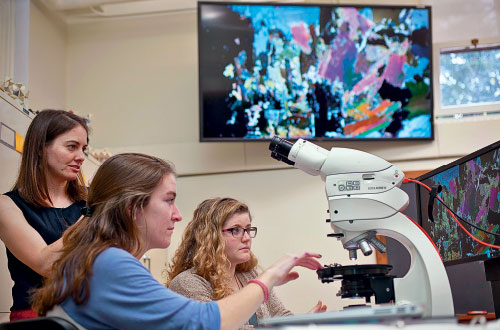State-of-the-Art Geology Lab
Tucked in Van Wickle Hall’s basement, near a display of fossilized dinosaur bones and rock specimens, is Lafayette’s smartest new classroom—the Petrographic Microscopy Laboratory. Its extraordinary state-of-the-art technology allows students to study minerals in a whole new light.
The lab may be the first of its kind in an institution like Lafayette, says John Wilson, laboratory coordinator. “Some really big research institutions have similar setups, but with the help of our Instructional Technology department, we’ve interfaced the technology throughout the room in a way few liberal arts colleges can—and they don’t have the volume of microscopes or cameras that we have here,” says Wilson.
Inside, a room-sized U-shaped lab table is laid with magnificent slabs of polished granite. As Tamara Carley, assistant professor of geology and geosciences and the lab’s primary user, explains, each slab contains countless minerals that tell a story about how the earth’s divergent forces create and change rock structure throughout the eons.
“We selected pieces that represent the full rock cycle: igneous, sedimentary, and metamorphic. By standing in this room and walking around our table, you get to travel through the entire cycle, and you’re able to put together an origin story for each slab,” Carley says.
“This shows us how mineralogy applies to the outside world—you can see it happening under the microscope as it would outside the classroom,” says environmental science major Annika Leiby ’18 (Damascus, Md.) while identifying minerals in a slice of rock under the microscope.

Tamara Carley, assistant professor of geology and geosciences (left) assists students Annika Leiby ’18, (center) and Lissie Connors ’18, with identifying a sample using the new high-tech lab with petrographic microscopes in Van Wickle Hall.